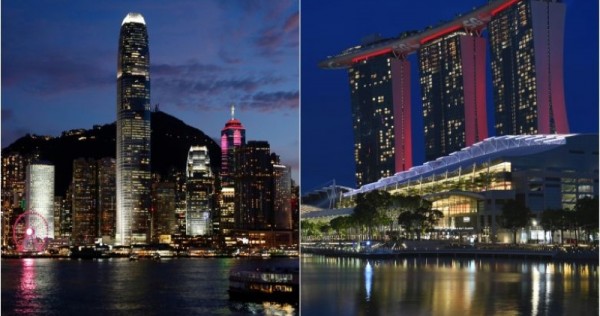Hong Kong’s beleaguered tourism sector has called on government officials to speed up talks with their Singaporean counterparts about a travel bubble it hopes might jump-start the dying industry.
But a local respiratory specialist has argued the government would be better off prioritising such low-risk destinations as mainland China or Macau in its initial travel partnerships, noting the higher chance of Covid-19 infections presented by medium-risk countries like Singapore.
The tourism sector’s Wednesday plea came a day after Singapore Transport Minister Ong Ye Kung said his country had responded “positively” to Hong Kong’s desire to establish an “air travel bubble” that would exempt travellers on both sides from compulsory 14-day quarantine.
“We hope to commence discussions with Hong Kong and other partners soon,” Ong said during a speech detailing recovery plans for the city state’s battered aviation sector and its national carrier, Singapore Airlines.
Almost 400,000 travellers from Hong Kong entered Singapore in 2018. Countries around the world have been rushing to establish bubbles to help airlines and local tourism sectors recover from the debilitating effects of the Covid-19 pandemic, which has forced border closures and paralysed international travel.
Last month, commerce chief Edward Yau Tang-wah provided a ray of hope in the coronavirus gloom, revealing the government had approached 11 countries since mid-June about the long-sought travel corridors. Singapore, Germany and France were among the six countries said to have reciprocated interest.
To make the bubbles possible, Yau said coronavirus tests before departure and again upon arrival would be necessary, and the two sides would need to discuss whether negative results at both ends meant travellers could skip quarantine or simply spend a shorter period in isolation.
A source familiar with the planning of travel bubbles said the government was making positive progress with Singapore.
In an email to the Post, the Tourism Commission said the government was moving to make cross-border travel a reality in a gradual and orderly manner.
“We have established an interdepartmental task force … to explore
“Discussions with relevant countries, including Singapore, are under way. Relevant announcements will be made in due course.”
Tourism sector lawmaker Yiu Si-wing said he hoped the government could kick-start the Singapore bubble by first allowing tour groups, business travellers and those visiting family to begin travelling in November.
“I hope the government can roll out travel bubbles with Singapore next month. We can start with a limited quota for these priority groups first, and if things go well, we could further open up the travel bubbles,” he said.
Yiu said risks could be more easily managed among tour groups, as the authorities could impose protocols for Covid-19 testing and disinfections, contact tracing and social distancing among them.
“I understand that as long as both sides can establish mutually accepted protocols such as testing and public hygiene standards, the arrangement of entries and departures, and monitoring mechanisms, it’s not that difficult to form a travel bubble with each other,” he said, adding that testing fees should be reasonable for both sides.
Singapore has so far recorded more than 57,800 Covid-19 infections, while Hong Kong has a tally of 5,143 infections. The two cities logged 10 and 11 new cases, respectively, on Wednesday.
However, Dr Leung Chi-chiu, a respiratory specialist, said if the government wanted to create travel bubbles, its first priority should be mainland China and Macau, noting both their massive economic relevance to the city and status as low-risk destinations.
“The travel bubble with Singapore will not help the local economy much. Its economic benefits to Hong Kong are very limited,” he said.
“Besides, Singapore is like Hong Kong. It has still failed to break the chain of Covid-19 transmission, with new infections emerging every day. If Hong Kong forms a travel bubble with Singapore, there is still a risk of cross-infections between both places.
“The first priorities for forming travel bubbles should be low-risk places such as mainland China and Macau, as they could create huge economic benefits for Hong Kong and carry lower risk of infection.”
Leung said the government should carefully monitor the pandemic situation over the next two weeks before deciding whether to implement a travel bubble with Singapore.
“Ideally, the government should wait until there are zero new infections before implementing any bubbles, otherwise they will only be short-lived and not economically viable, as the pandemic could rebound very quickly,” he warned.
But Freddy Yip Hing-ning, president of the Hong Kong Travel Agent Owners Association, said the government should speed up its negotiations with the Singaporean government and roll out the travel bubbles as soon as possible.
“The government should act quickly. We can’t keep waiting and waiting, as many people are starving. The travel bubbles could serve as a driver to kick-start the economic recovery, especially for the aviation sector,” he said.
For the latest updates on the coronavirus, visit here.
This article was first published in South China Morning Post.
This article was first published in Asia One . All contents and images are copyright to their respective owners and sources.











